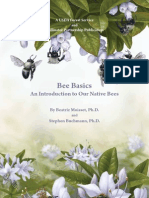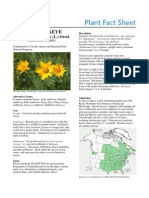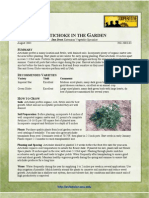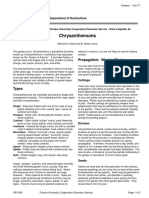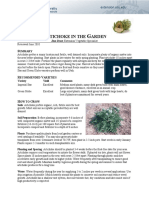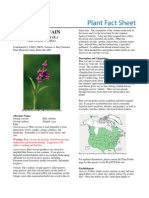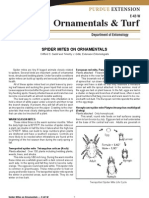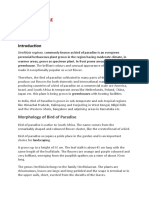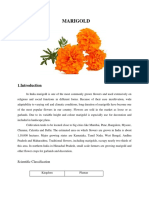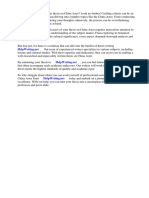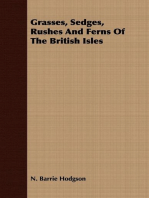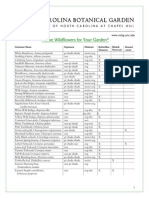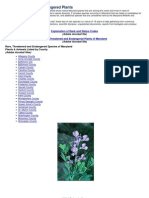Professional Documents
Culture Documents
Crooked-Stem Aster: Symphyotrichum Prenanthoides (Muhl. Ex Willd.) G.L. Nesom - Plant Fact Sheet - Plant Materials Center, Beltsville, MD
Uploaded by
Maryland Native Plant ResourcesOriginal Title
Copyright
Available Formats
Share this document
Did you find this document useful?
Is this content inappropriate?
Report this DocumentCopyright:
Available Formats
Crooked-Stem Aster: Symphyotrichum Prenanthoides (Muhl. Ex Willd.) G.L. Nesom - Plant Fact Sheet - Plant Materials Center, Beltsville, MD
Uploaded by
Maryland Native Plant ResourcesCopyright:
Available Formats
Plant Fact Sheet
CROOKED-STEM ASTER
Symphyotrichum prenanthoides (Muhl. ex Willd.) G.L. Nesom
Plant Symbol = SYPR6
Contributed by: USDA, NRCS, National Plant Materials Center, Beltsville, MD native landscape gardens. Asters will grow on disturbed sites and can be used for wildlife habitat restoration. Crooked stem aster is attractive to pollinators, including long-tongued bees, short-tongued bees, small to mediumsized butterflies, and skippers. Many kinds of insects feed on the foliage and other parts of asters, including the caterpillars of the butterfly Chlosyne nycteis (Silvery Checkerspot) and many moth species. Wild Turkey, other upland game birds and mammalian herbivores occasionally eat the seeds and foliage of asters, even though their food value is low. Status Crooked-stem aster is listed as a special concern in Connecticut and as threatened in Massachusetts. Please consult the PLANTS Web site and your State Department of Natural Resources for this plants current status (e.g. threatened or endangered species, state noxious status, and wetland indicator values). Description and Adaptation Crooked-stem aster is a native, perennial wildflower that grows from 1 4 feet tall. The asters rigid stems are much-branched from the base. The leaves are .5 3 inches long, simple (not made up of multiple leaflets), and alternate (progressing singly up the stem). The flowers are fragrant with approximately 30 blue ray florets per flower. The disk florets are yellow and the bracts are glandular with long, green, loose or spreading tips. Flowers appear in summer and give way to flat, brown, hairy achenes (dry fruits). Crooked-stem aster spreads through stolons (horizontal stems that produce new plants from buds). Distribution: Crooked-stem aster grows in moist, loamy soils, full sun to partial shade in riparian and forest edge habitats. It is distributed from Ontario south to North Carolina and Tennessee (USDA cold hardiness zones 4 7).
Randall Roden, Prairie Nursery Inc.
Alternate Names Crooked stem aster Zigzag aster Aster prenanthoides L. Uses Crooked stem aster is an adaptable, easy to grow ground cover for dry, sunny locations. It is a native plant and can be part of a good wildlife seed mixture where native grasses and wildflowers are seeded together. Ethno botanical: A tea made from the roots of crooked-stem aster has been used to treat fevers in babies and colds and kidney ailments in adults. Landscaping and wildlife: Crooked-stem aster creates showy mounds of blooms in summer and is excellent for
Establishment Seed propagation Seeds can be collected from wild plants in the fall when the seed separate easily from the stems that attached them to the flower. Seeds should be collected in paper bags and allowed to dry for 12 weeks. If seeds are sown directly, sow them five-eighths of an inch deep in the fall and sow thickly. Plant a cover crop of a cool-season annual grass over the seedbed to protect seed over the winter. If seeds are to be propagated in a container, they should be stored for 13 months at 3040 degrees Fahrenheit before sowing. Many species of Aster benefit from moisture during the cold storage (stratification) period. Use a perlite/vermiculite mix for stratification. The seed will germinate in 10 to 15 days at 72 degrees Fahrenheit. Germination to true leaf stage is 7 to 15 days. Seedlings are thinned at this stage. Vegetative propagation Propagate by softwood cuttings taken in late spring. Management Crooked-stem aster colonizes by horizontal stems which grow at the soil surface, so thin it regularly to control its spread. Crooked-stem aster may open up if it becomes too top-heavy, so prune it back by no more than half in mid-June to keep it thick. After it goes dormant in late fall or early winter cut it back to the round level ring of leaves at the plants base. Crooked-stem aster prefers neutral to slightly acidic soils. Pests and Potential Problems Crooked stem aster is susceptible to many leaf spots, rusts and mildews which will affect the lower leaves but usually do no permanent damage. The most destructive diseases in the cultivation of asters are various forms of stem-rot. They are of fungus origin and are induced by allowing the plants to remain moist for an extended period of time. The infection usually takes place in the seed-row, but often no effect is noticed until the plants are nearly full-grown, when they suddenly wilt and die. The yellow disease causes the plants to have a bleached appearance and to make a spindling growth. Thorough cultivation of the soil is the best preventive. Environmental Concerns No concerns at this time. Cultivars, Improved, and Selected Materials (and area of origin) There are no recommended cultivars or selected materials at this time. Crooked stem aster is available from commercial nurseries specializing in native plants.
Prepared By: Samantha Kirk, (Horticultural Volunteer) Shawn Belt, NRCS, National Plant Materials Center, Beltsville, MD Species Coordinator: Shawn Belt, NRCS, National Plant Materials Center, Beltsville, MD Published: March 2009 Edited: 07-Nov-2008 SMK For more information about this and other plants, please contact your local NRCS field office or Conservation District <http://www.nrcs.usda.gov/>, and visit the PLANTS Web site <http://plants.usda.gov> or the Plant Materials Program Web site <http://plantmaterials.nrcs.usda.gov>
USDA IS AN EQUAL OPPORTUNITY PROVIDER AND EMPLOYER
You might also like
- Bee Basics: An Introduction To Our Native BeesDocument48 pagesBee Basics: An Introduction To Our Native BeesMaryland Native Plant Resources100% (1)
- The Bush FruitsDocument48 pagesThe Bush Fruitsrazno001No ratings yet
- Citrus Propagation: Fact Sheet HS-86Document6 pagesCitrus Propagation: Fact Sheet HS-86Dorjee WangNo ratings yet
- Staghorn Ferns For FloridaDocument4 pagesStaghorn Ferns For FloridaNguyễnThanhHùngNo ratings yet
- Invasive Flora of the West Coast: British Columbia and the Pacific NorthwestFrom EverandInvasive Flora of the West Coast: British Columbia and the Pacific NorthwestNo ratings yet
- Indoor PlantsDocument46 pagesIndoor Plantsmeghapandu100% (2)
- Beneficial and Harmful InsectsDocument25 pagesBeneficial and Harmful InsectsVimala Elumalai100% (1)
- The 10 Best Succulents You Can Grow IndoorsDocument14 pagesThe 10 Best Succulents You Can Grow IndoorsedasoomNo ratings yet
- Plant Invaders of Mid-Atlantic Natural AreasDocument172 pagesPlant Invaders of Mid-Atlantic Natural AreasMaryland Native Plant ResourcesNo ratings yet
- A Perennial Flower Bed DesignDocument4 pagesA Perennial Flower Bed Designelamo2No ratings yet
- Managing Alternative PollinatorsDocument170 pagesManaging Alternative PollinatorsAvantgardens100% (2)
- Attracting Pollinators To Your Garden Using Native PlantsDocument16 pagesAttracting Pollinators To Your Garden Using Native PlantsMaryland Native Plant ResourcesNo ratings yet
- Rare, Threatened, and Endangered Plants of Maryland, April 2010Document33 pagesRare, Threatened, and Endangered Plants of Maryland, April 2010Maryland Native Plant ResourcesNo ratings yet
- Durock Cement Board System Guide en SA932Document12 pagesDurock Cement Board System Guide en SA932Ko PhyoNo ratings yet
- Sustainable Methow Seed Saving GuideDocument1 pageSustainable Methow Seed Saving Guidesjbutman100% (1)
- Ground-Fault Protection - All You Need To KnowDocument9 pagesGround-Fault Protection - All You Need To KnowCamila RubioNo ratings yet
- Plants For Pollinators: Outer Coastal Plain Mixed Province - A Regional Guide For Farmers, Land Managers, and GardenersDocument24 pagesPlants For Pollinators: Outer Coastal Plain Mixed Province - A Regional Guide For Farmers, Land Managers, and GardenersMaryland Native Plant ResourcesNo ratings yet
- Cash and Cash Equivalents ReviewerDocument4 pagesCash and Cash Equivalents ReviewerEileithyia KijimaNo ratings yet
- Grafting and Budding: A Practical Guide for Fruit and Nut Plants and OrnamentalsFrom EverandGrafting and Budding: A Practical Guide for Fruit and Nut Plants and OrnamentalsNo ratings yet
- 2 Effective Manufacturing ERP MESDocument17 pages2 Effective Manufacturing ERP MESm_trang2005100% (2)
- Capstone-ModDocument25 pagesCapstone-ModMohammad Ryyan PumbagulNo ratings yet
- All About HerbicidesDocument28 pagesAll About Herbicidesmexx4u2nv100% (1)
- ScienceDocument17 pagesScienceTambong HailyNo ratings yet
- Hairy Small-Leaf Ticktrefoil: Desmodium Ciliare (Muhl. Ex Willd.) DC. - Plant Fact Sheet - Plant Materials Center, Beltsville, MDDocument2 pagesHairy Small-Leaf Ticktrefoil: Desmodium Ciliare (Muhl. Ex Willd.) DC. - Plant Fact Sheet - Plant Materials Center, Beltsville, MDMaryland Native Plant ResourcesNo ratings yet
- Types of WeedsDocument8 pagesTypes of WeedsEdsel Busa100% (1)
- NARROWLEAF SILKGRASS Pityopsis Graminifolia (Michx.) - Plant Fact Sheet - Plant Materials Center, Beltsville, MDDocument2 pagesNARROWLEAF SILKGRASS Pityopsis Graminifolia (Michx.) - Plant Fact Sheet - Plant Materials Center, Beltsville, MDMaryland Native Plant ResourcesNo ratings yet
- Prosopis Juliflora AZT™', AZT™' Native MesquiteDocument2 pagesProsopis Juliflora AZT™', AZT™' Native MesquiteMara LiceoNo ratings yet
- Scientific Name: Agapanthus Praecox Willd Common Name: Blue Lily or African Lily DescriptionDocument11 pagesScientific Name: Agapanthus Praecox Willd Common Name: Blue Lily or African Lily DescriptionJey VlackNo ratings yet
- MG 10600Document3 pagesMG 10600bstscribdNo ratings yet
- Smooth Oxeye: Heliopsis Helianthoides (L.) Sweet - Plant Fact Sheet - Plant Materials Center, Beltsville, MDDocument2 pagesSmooth Oxeye: Heliopsis Helianthoides (L.) Sweet - Plant Fact Sheet - Plant Materials Center, Beltsville, MDMaryland Native Plant ResourcesNo ratings yet
- Phyllotreta Cruciferae P Striolata: Flea Beetle Biology (, .)Document2 pagesPhyllotreta Cruciferae P Striolata: Flea Beetle Biology (, .)Suresh VermaNo ratings yet
- Ecology - Jimsonweed - SAREDocument1 pageEcology - Jimsonweed - SAREcartersmrNo ratings yet
- Prairie Plant Profiles: Freedom Trail Park Westfield, INDocument25 pagesPrairie Plant Profiles: Freedom Trail Park Westfield, INdevender143No ratings yet
- KudzuDocument6 pagesKudzuDonovan WagnerNo ratings yet
- Artichoke in The GardenDocument2 pagesArtichoke in The GardenCharlesNo ratings yet
- Chrysanthemums: Propagation: What To PlantDocument2 pagesChrysanthemums: Propagation: What To PlantOgix UcupNo ratings yet
- Scientific Name FinDocument10 pagesScientific Name FinJey VlackNo ratings yet
- Artichoke in The GardenDocument2 pagesArtichoke in The Gardenmalenna00No ratings yet
- Black Eyed SusanDocument5 pagesBlack Eyed SusanyoyosubagioNo ratings yet
- Rubber ChickenDocument2 pagesRubber ChickenAllison V. MoffettNo ratings yet
- Watercress in The GardenDocument2 pagesWatercress in The GardenDodik Novie PurwantoNo ratings yet
- Black LocustDocument2 pagesBlack LocustGgy VictorNo ratings yet
- 11 Weeds FDocument44 pages11 Weeds FJigten Trashi DorjeeNo ratings yet
- Tanaman Phragmites AustralisDocument6 pagesTanaman Phragmites AustralisAulia QisthiNo ratings yet
- Symphyotrichum Chilense (Nees) G.L. NesomDocument2 pagesSymphyotrichum Chilense (Nees) G.L. Nesomnabar73500No ratings yet
- Hedges For Wildlife: How To Pick, Plant and Manage A Wildlife-Friendly HedgeDocument2 pagesHedges For Wildlife: How To Pick, Plant and Manage A Wildlife-Friendly HedgehareramaaNo ratings yet
- HorticultureDocument12 pagesHorticultureNarendra WijayasuriyaNo ratings yet
- American Vetch: Vicia Americana Muhl. Ex Willd. - Plant Fact Sheet - Plant Materials Center, Beltsville, MDDocument2 pagesAmerican Vetch: Vicia Americana Muhl. Ex Willd. - Plant Fact Sheet - Plant Materials Center, Beltsville, MDMaryland Native Plant ResourcesNo ratings yet
- Aw22jwjehwsparagusjjhhbbuu71919191933 in The GardenDocument3 pagesAw22jwjehwsparagusjjhhbbuu71919191933 in The GardenRed DiggerNo ratings yet
- Blue Vervain: Verbena Hastata (L.) - Plant Fact Sheet - Plant Materials Center, Beltsville, MDDocument2 pagesBlue Vervain: Verbena Hastata (L.) - Plant Fact Sheet - Plant Materials Center, Beltsville, MDMaryland Native Plant ResourcesNo ratings yet
- Specialty Crop Profile: Pawpaw: Tony Bratsch, Extension Specialist, Small Fruit and VegetablesDocument3 pagesSpecialty Crop Profile: Pawpaw: Tony Bratsch, Extension Specialist, Small Fruit and VegetablesfodoNo ratings yet
- 0.3 Chapter IiDocument14 pages0.3 Chapter IiReynaldo IlustreNo ratings yet
- Principal Parts of A Grass PlantDocument6 pagesPrincipal Parts of A Grass PlantOliver TalipNo ratings yet
- Purdue ExtensionDocument4 pagesPurdue ExtensionmdollNo ratings yet
- Literature Review of Amaranthus CaudatusDocument5 pagesLiterature Review of Amaranthus Caudatusafmzzgeqdsedez100% (1)
- Plant Guide: Alsike CloverDocument4 pagesPlant Guide: Alsike CloverKhaledabuaglaNo ratings yet
- Bird of ParadiseDocument11 pagesBird of ParadisePratik RautNo ratings yet
- Marigold PDFDocument20 pagesMarigold PDFPrajakt RaulNo ratings yet
- Croton ProductionDocument7 pagesCroton ProductionManu MandaNo ratings yet
- Jade VineDocument18 pagesJade VineArk WantuNo ratings yet
- Teosinte: Here's A ListDocument10 pagesTeosinte: Here's A ListMd. Sazzad HossainNo ratings yet
- Thesis On China AsterDocument6 pagesThesis On China Asterjenniferyorknorman100% (2)
- Dessert Rose Adenium ObesumDocument8 pagesDessert Rose Adenium ObesumDiego FariasNo ratings yet
- Zamia Integrifolia - CoontieDocument7 pagesZamia Integrifolia - Coontiepepe_carambolaNo ratings yet
- Pest Alert: Florida Department of Agriculture and Consumer Services, Division of Plant IndustryDocument4 pagesPest Alert: Florida Department of Agriculture and Consumer Services, Division of Plant IndustryJoeyDragneelNo ratings yet
- BiomegardenDocument4 pagesBiomegardenapi-270700888No ratings yet
- Common Weeds of GippslandDocument22 pagesCommon Weeds of GippslandaaguilardNo ratings yet
- Erythrina Crista-Galli: Infestation (Photo: Sheldon Navie)Document3 pagesErythrina Crista-Galli: Infestation (Photo: Sheldon Navie)YudaHendriawanNo ratings yet
- 2011 European Frogbit Removal Management Plan Appendix BeDocument1 page2011 European Frogbit Removal Management Plan Appendix BelewiscreekNo ratings yet
- Wild Plants for Cage Birds - Weed and Seeds of the Field and Wayside Described - With Footnotes, etc., by G. E. WestonFrom EverandWild Plants for Cage Birds - Weed and Seeds of the Field and Wayside Described - With Footnotes, etc., by G. E. WestonNo ratings yet
- A Checklist For The Vascular Plants of Great Smoky Mountains National ParkDocument27 pagesA Checklist For The Vascular Plants of Great Smoky Mountains National ParkMaryland Native Plant ResourcesNo ratings yet
- Conservation & Management of North American BumblebeesDocument18 pagesConservation & Management of North American Bumblebeesbjd24No ratings yet
- Native Wildflowers For Your Garden - North Carolina Botanical GardenDocument6 pagesNative Wildflowers For Your Garden - North Carolina Botanical GardenMaryland Native Plant ResourcesNo ratings yet
- Maryland Landscapes That Help The Chesapeake Bay - MD Cooperative ExtensionDocument4 pagesMaryland Landscapes That Help The Chesapeake Bay - MD Cooperative ExtensionMaryland Cooperative ExtensionNo ratings yet
- Maryland Rare, Threatened and Endangered PlantsDocument2 pagesMaryland Rare, Threatened and Endangered PlantsMaryland Native Plant ResourcesNo ratings yet
- Biomolecules ExtractionDocument6 pagesBiomolecules ExtractionBOR KIPLANGAT ISAACNo ratings yet
- Capacity Requirement PlanningDocument17 pagesCapacity Requirement PlanningvamsibuNo ratings yet
- Factory OverheadDocument2 pagesFactory OverheadKeanna Denise GonzalesNo ratings yet
- HumareaderDocument37 pagesHumareaderStefan JovanovicNo ratings yet
- Practical Cookery 14th Edition SAMPLEDocument16 pagesPractical Cookery 14th Edition SAMPLETendaiNo ratings yet
- Stereochemistry Chiral Molecules QuizDocument3 pagesStereochemistry Chiral Molecules QuizSean McDivittNo ratings yet
- TC 000104 - VSL MadhavaramDocument1 pageTC 000104 - VSL MadhavaramMK BALANo ratings yet
- Post Traumatic Stress DisorderDocument2 pagesPost Traumatic Stress Disorderapi-188978784100% (1)
- TelfastDocument3 pagesTelfastjbahalkehNo ratings yet
- FNCP Improper Waste DisposalDocument2 pagesFNCP Improper Waste DisposalKathleen Daban RagudoNo ratings yet
- Multilevel Full Mock Test 5: Telegramdagi KanalDocument20 pagesMultilevel Full Mock Test 5: Telegramdagi KanalShaxzod AxmadjonovNo ratings yet
- The Integration of Technology Into Pharmacy Education and PracticeDocument6 pagesThe Integration of Technology Into Pharmacy Education and PracticeAjit ThoratNo ratings yet
- Poster For Optimisation of The Conversion of Waste Cooking Oil Into BiodieselDocument1 pagePoster For Optimisation of The Conversion of Waste Cooking Oil Into BiodieselcxmzswNo ratings yet
- Tomography: Tomography Is Imaging by Sections or Sectioning Through The Use of AnyDocument6 pagesTomography: Tomography Is Imaging by Sections or Sectioning Through The Use of AnyJames FranklinNo ratings yet
- Technical Publication: Direction 2296441-100 Revision 06 Ge Medical Systems Lightspeed 3.X - Schematics and BoardsDocument380 pagesTechnical Publication: Direction 2296441-100 Revision 06 Ge Medical Systems Lightspeed 3.X - Schematics and BoardsJairo Manzaneda100% (2)
- Chan v. ChanDocument2 pagesChan v. ChanjdpajarilloNo ratings yet
- Wa0016Document3 pagesWa0016Vinay DahiyaNo ratings yet
- Virtual or Face To Face Classes Ecuadorian University Students' Perceptions During The Pandemic by Julia Sevy-BiloonDocument1 pageVirtual or Face To Face Classes Ecuadorian University Students' Perceptions During The Pandemic by Julia Sevy-BiloonPlay Dos ChipeadaNo ratings yet
- S:/admin/mpi/MP1169 - Amaia Skies Samat/000 - ACTIVE DOCUMENTS/09 - SPECS/2013-07-23 - Design Development/04-Plumbing/15050Document19 pagesS:/admin/mpi/MP1169 - Amaia Skies Samat/000 - ACTIVE DOCUMENTS/09 - SPECS/2013-07-23 - Design Development/04-Plumbing/15050Lui TCC BariaNo ratings yet
- Brain Slides SEMINAR 1 - 220606 - 142811 - 220606 - 223805Document32 pagesBrain Slides SEMINAR 1 - 220606 - 142811 - 220606 - 223805pang pangNo ratings yet
- The Power of PositivityDocument5 pagesThe Power of PositivityYorlenis PintoNo ratings yet
- Management of Developing DentitionDocument51 pagesManagement of Developing Dentitionahmed alshaariNo ratings yet
- Chapter 54 - Drugs Acting On The Upper Respiratory TractDocument13 pagesChapter 54 - Drugs Acting On The Upper Respiratory TractJonathonNo ratings yet
- Gmail - RedBus Ticket - TN7R20093672Document2 pagesGmail - RedBus Ticket - TN7R20093672Bappa RoyNo ratings yet
